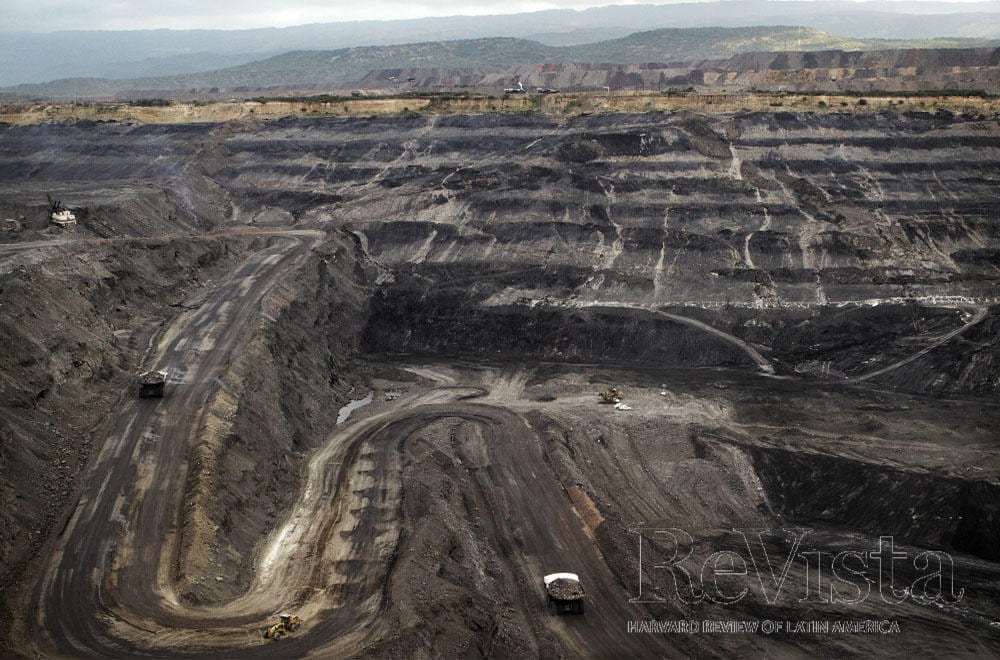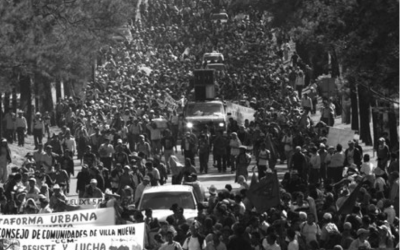In the Name of Development
Moving Cerrejón Mountain, Its Coal, and Its People

Mountains sacred to the Wayuu have become casualties of Cerrejón’s open-pit coal mine. Photo by Ronald de Hommel.
Just over a generation ago, Wayúu healers made ritual journeys to Cerrejón Mountain, where they gathered traditional plants for remedying community members’ ailments. The people of La Guajira, Colombia, roamed the land with little restriction in those days, enabling them to subsist through hunting, fishing, crop harvesting and livestock grazing, and to enjoy historical and sacred spaces that reinforced their shared identity. Yet a 1975 agreement struck between the Colombian government and Exxon to export the region’s coal profoundly changed these social and economic rhythms.
The Cerrejón Mine Corporation undertook exploratory activities in 1977, followed by railway, port, and road construction efforts between 1981-1986 that paved the way for extractive operations. The reins of the enterprise changed hands in later years following Colombia’s decision to fully privatize the mine in 2000 and Exxon’s departure in 2002. Cerrejón’s open-pit coal mine, now the largest in the world, has been jointly owned in equal shares by Anglo American, BHP Billiton, and Xstrata since 2006.
A short documentary produced by Exxon in 1988 to showcase its early work in La Guajira emphasized the separate and peaceful coexistence of the Wayúu on one hand and Cerrejón’s pursuits and affiliates on the other. “The Wayúu … do what they must to keep their way of life intact,” the narrator affirmed against a backdrop of images depicting their subsistence activities, “the influence of a great industrial venture all around them, largely unseen.” Twenty-two years later, Cerrejón similarly asserted in response to concerns raised by NGO DanWatch, “Cerrejón’s relations with the Wayúu … [have] always been peaceful.” Yet the evidence suggests a far more complicated reality.
The period immediately preceding the film’s production found Exxon relocating property owners from territories provisioned by the government for mining operations. Negotiations fixed the form and scale of compensation, but did not serve as a forum for denying access to the land. Some resisted Exxon’s relocation efforts, while others were placated by its development promises. Yet even the latters’ support for Exxon’s presence was overwhelmingly short-lived.
“On its arrival, the mining company offered the Wayúu participation in the benefits of coal mining,” Remedios Fajardo Gómez recalls in the 2007 edited volume, The People Behind Colombian Coal. “This implied ‘development’ and ‘progress,’ which for the Wayúu meant the solution to the problems of water supply, education, health and sustainable development…. We ceded our ancestral land as a ‘loan.’” But “[a]s time passed,” she explains, “the relationship deteriorated and the community slowly began to realize the implications of the mining company’s proposals…. Each time the communities were affected by the company’s actions, we protested—but our protests were never heeded…. We realized that we had made a mistake.”
The absence of laws requiring disclosure of mining’s negative impacts left the communities unprepared for such consequences as the ongoing destruction of their sacred mountains (which offends their spiritual sensibilities and limits their ability to engage in important cultural practices), severe dust generation that has disproportionately plagued children with acute respiratory infections (now the principal source of morbidity in the districts of Barrancas and Hatonuevo), water contamination, noise pollution that has disrupted their routines and damaged homes, and the loss of sufficient land for the physical survival and social sustenance of many communities arising from the scale and specific placement of Cerrejón’s acquisitions.
Colombia incorporated International Labour Organization Convention 169 into its constitution in 1991, affirming indigenous peoples’ right to consultations that would enable them to “decide their own priorities for the process of development” and “participate in the formulation, implementation, and evaluation of [development] plans.” The country further endorsed the United Nations Declaration on the Rights of Indigenous Peoples in 2009, which protects indigenous peoples’ right to give and withhold free, prior, and informed consent [herein FPIC] for development projects. Though Colombian Constitutional Court decisions have subsequently supported consultations and FPIC, establishing particularly in a 2009 ruling that “[t]he abstract general interest and majority vision of development cannot be imposed when such projects are developed in indigenous peoples’ territories,” the national government has provided little enforcement, and even requested that the 2009 decree be overturned.
In 2011, community activists told a Witness for Peace delegate that Cerrejón’s consultations “just inform[ed] the communities” of their plans and “never [warned] them about [mining’s] negative consequences.” They noted further that Cerrejón “only gather[s] together some …authorities” without including “the rest of the community,” and explained that “[i]f the cabildos [councils] do not … sign the document that the mining officials have prepared, they are subject to pressure, and even threats. The mining company then takes the document to the Ministry of the Interior and presents it as a prior consultation with the communities.”
Cerrejón has deflected accusations of human rights violations by hiding behind the state. “If the human rights of the people in the nearby communities are being violated, it is the responsibility of the government of Colombia to protect its citizens,” Cerrejón’s president asserted in 2006. In addressing a 2010 criticism of its role in Tabaco’s 2001 expropriation, Cerrejón dodged responsibility by suggesting that “the state eviction of families” (in which the national police and army assisted Cerrejón in the latter’s appeal for a forced eviction) was “lamentable.” Though Cerrejón pledged in May 2013 to design new programs through which communities “will be fully informed of and have the opportunity to participate in decisions that may affect them,” a July 2013 communication announcing its plans for another forced expropriation by the Colombian state overshadows the promise of this development.
Cerrejón justifies its coal mining operations in La Guajira on three grounds, the first being the “opportunity for improving… standards of living,… and strengthening… social capital” through its resettlements. Reviews of recent development outcomes by resettlees have been mixed. Community leader Doris Carrillo, who hails from the non-indigenous peasant community of Patilla, affirmed the desirability of her new setting, as reported by Oliver Balch in a July 2013 Guardian article. “Here we have electricity and running water, and a school with five classrooms. … [T]he health center is just five minutes away,” she explains. “I couldn’t condemn my children to the reality we used to live.” Yet residents from Chancleta fear resettlement will reduce their opportunities. PBI Colombia reported in 2011 that Chancleta’s Community Action Committee representative doubted many farmers could survive there. They noted further that residents would “have to learn to grow crops in small lots of arid land rather than the vast plots that they once had at their disposal,” and that the new location has even greater pollution.
Cerrejón’s vision is undermined further by the significance Wayúu and Afro-Colombians attach to their native residences. Though trappings of material development may be provided on alternate lands, it comes at the price of parting with centuries-old historical sites that memorialize Afro-Colombians’ salvation from European captors and their subsequent survival strategies, as well as territories occupied by the Wayúu for millennia that are intricately interlaced with their creation mythology, representing vital resources for the maintenance of social capital that Cerrejón seeks to strengthen through resettlement.
The destruction of homes and schools with which recent history and memories are bound poses yet another drawback to the resettlement arrangement, as does the “psychological trauma,” as displaced Tabaco resident José Julio Pérez puts it, “that at any moment you can disappear from your land.” The trauma of displacement may be accompanied by such alleged tactics to expedite resettlement negotiations as delaying potable water deliveries, cutting off electricity, offering special financial rewards to the first families to leave (frustrating collective negotiation efforts and contributing to intercommunal tension), smearing reputations, and threatening to initiate legal proceedings for forced expropriation if a settlement is not reached promptly. Thus, “development through resettlement” as justification for Cerrejón’s presence is beset by problems.
Social development programs form the second basis on which Cerrejón legitimizes its presence. They have boasted of their development contributions generally: “Roads, electrical grids, and ancillary infrastructure are now present in the region as a direct result of the coal extraction. A formal work ethos has been installed.” These Eurocentric conceptions of progress (which clash, for instance, with many Wayúus’ grievances about the “ripp[ing] open” of their sacred hills and mountains for road construction and the subsequent unwanted visitors roads deliver) have routinely guided Cerrejón’s selection of projects, such that communities are frequently alienated rather than supported by them.
One example is Cerrejón’s recent provision of electricity to select communities in Alta Guajira. “2011 will be remembered … as the year in which … a dream came true for [these] residents,” Cerrejón reported in a press release. “They will finally receive electric power services” following “more than two years of intense negotiations [by Cerrejón] with IPSE and Electrocaribe … [W]orkshops were held [earlier this week] to introduce the project to the benefiting communities.”
Cerrejón’s failure to introduce the project at its initial stage suggests that community members had neither the opportunity to collectively decide whether they desired the electricity and wished to give consent, nor the ability to access information about potential negative consequences to ensure that it was in their best interest. Beneficiaries from the Media Luna community, for instance, had expressed despair in past years about their inability to subsist on their remaining land following adjacent appropriations by Cerrejón. Would the installation of power lines further encroach upon their limited space for livestock grazing and hunting, interfere with sacred sites (such as their cemetery), or otherwise impact how they interacted with the land? Were they prepared and willing to endure the visual blight of the infrastructure in exchange for the electricity? And had each community member determined how s/he would find the means to pay for the electricity, both now and after Cerrejón ceases operations in 2034?
Another example of a social development project legitimized through a Eurocentric conception of progress is Cerrejón’s investment in the Waya Guajira hotel. Cerrejón’s press releases describe plans to use it for “ecotourism, with the purpose of driving progress for the local communities that will benefit directly from it,” and boast that “[i]t is the first hotel … with high international standards … in the country.” Yet there’s neither mention of dialogue with, nor receipt of FPIC to use the land for the hotel from, the local communities that Cerrejón suggests will “benefit directly from it.”
It is unclear whether surrounding communities would welcome tourism. If they do embrace it, negotiations to strategically locate the hotel such that benefits distribute across communities as equally as possible would be necessary to avert intercommunal conflict. An allegation from a local NGO representative that Cerrejón commissioned anthropologists and other professionals to “document traditional knowledge” for creating an authentic regional experience at the hotel (such as providing traditional Wayúu foods) is also alarming since profits would be made from their intellectual property without FPIC.
While some of Cerrejón’s projects have made positive contributions (particularly those mitigating Cerrejón’s environmental impact), their consistent pattern of creating and introducing projects, rather than implementing programs conceived of (or at least approved by) the communities, has in many cases exacerbated communities’ burdens. It’s also important to note that without FPIC, social development projects organized by Cerrejón will always present a danger, as fear of desired projects’ withdrawal encourages the stifling of grievances such that, intentionally or not, they become a form of coercion.
The final basis on which Cerrejón justifies its activities is the economic benefits distributed to Colombians through Cerrejón’s tax and royalty payments (totaling US$702.4 million in 2011), direct employment of 5,204 people, its extension of contract work to 4,333 additional citizens, and its support of external employment through domestic procurement. As Colombia’s largest private exporter in 2011 (with sales constituting 40.5 percent of Colombian exports), its operations also contributed significantly to currency stability.
In his inaugural address, Colombian president Juan Manuel Santos bolstered the financial justification by communicating his belief in mining’s ability to serve as a key “locomotive” (or “economic engine”) for Colombia’s development, facilitating peace, prosperity, and the creation of jobs. Yet NGOs like PBI Colombia express skepticism about mining as a means of moving the country and its people forward, citing increased environmental damage, social conflicts resulting from the development projects, and government failure to channel the previous decade’s natural resource wealth into “public investment in health, education, basic sanitation, potable water, energy and infrastructure” due to “institutional weakness, corruption, … and organized crime.”
Cerrejón has attempted to address the public investment problem by devoting resources to strengthening Colombia’s governing institutions, raising a critical question: Does the need for Cerrejón to assume such a role underscore the promise of its presence, or the peril? Oxford economist Paul Collier emphasizes in his book, The Bottom Billion, that strong checks and balances are vital for ensuring that natural resource income is invested in public goods, such that they should ideally precede natural resource extraction. Given Cerrejón’s presence nonetheless, we must consider whether Cerrejón can appropriately and effectively assume the role of institutional reformer, particularly in light of such conflicts of interest as its dependence upon the government for its operational license, the advantages it derives from the government’s failure to protect human rights, and its agenda (“establish[ing] conditions conducive to the subsequent expansion of the operation at higher levels,” as indicated in its 2011 sustainability report).
The financial justification advanced by Cerrejón and President Santos also forces the question: Should the wider country’s economic development be privileged over the protection of 846,641 Guajirans’ needs and rights? In a 1977 article addressing skepticism about the usefulness of empowering small societies to protect their ways of life from commercial encroachment, late Harvard anthropologist David Maybury-Lewis contended, “[T]he usefulness of their … social existence is not in doubt for the members of that culture. … [W]e must help other cultures to survive because in all conscience we have no alternative. It is a moral imperative of the sort that insists that the strong must not trample on the rights of the weak.”
Responding to the argument that “preventing ‘backward’ peoples from enjoying the benefits of civilization” is immoral (which legitimizes development by force), Maybury-Lewis submitted further, “[W]e know … that the introduction of new industries in remote and not-so-remote areas can lead to cultural breakdown and personal despair within the local population as well as providing jobs, increasing income, and so on. This is a familiar dilemma even in advanced societies, which is why people are so anxious to have a say in what happens to their own communities.” Harvard economist and philosopher Amartya Sen similarly rejects development by force, emphasizing in his book, Development as Freedom, that “expansion of freedoms [should be] … the primary end and … principal means of development.” He argues that development should not be understood chiefly as material progress, but as “the removal of various types of unfreedoms that leave people with little … opportunity of exercising their reasoned agency.”
If Guajirans (and particularly its indigenous and Afro-Colombian residents) had the freedom to choose, would they willingly sacrifice values, customs, and social bonds that are inextricably tied to the land in exchange for development? Given the existing spectrum of opinions, it’s safe to say that some would consent to the tradeoff and others would not. The former position is a familiar one in the West; the latter stance, less familiar to the Western imagination, might sound something like Lorena Hernández’s appeal in a 2010 documentary produced by Fuerza Mujeres Wayúu. “My message for all those who want to help us from their heart … is that we should become more aware of what we have,” she says, gesturing around her at her community’s rustic landscape. Ironically, Exxon’s 1988 film, quoting an unknown and unseen Wayúu, echoes the sentiment poignantly. “We are poor, some say. But I say, we are rich. We have the sea, we have women, and the sun. Who has more than we? My land is good because it is mine.”
Winter 2014, Volume XIII, Number 2
Erica Jaffe Redner is a research assistant at Harvard University and an MA candidate in anthropology at the University of Pennsylvania. Her most recent work examines the condition of a community of American oil workers in the context of prevailing socioeconomic norms, and considers what they’re owed by their corporate employers on moral grounds.
Related Articles
Making a Difference: Building Blocks
Since the first, unplanned visit of a Brazilian entrepreneur in 2011 to Harvard’s Center on the Developing Child, a diverse group of professors, practitioners, civil society leaders and other committed individuals at Harvard and in Brazil have…
Travails of a Miner, VIP-style
English + Español
Sergio Sepúlveda is a Chilean miner with an enviable salary—equivalent to that earned by a university-educated professional. He owns a brand new Korean-made car, and every three years…
Indigenous People and Resistance to Mining Projects
English + Español
Latin America’s governments and its indigenous peoples are clashing over the issue of mining. Governments, motivated by economic growth, have established legal frameworks to attract foreign investments to extract mining resources. When those resources are located in…




